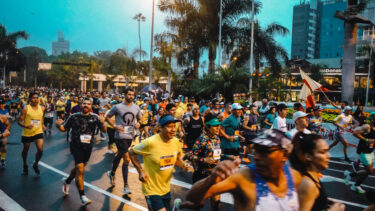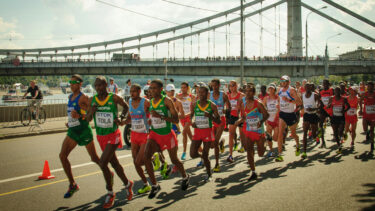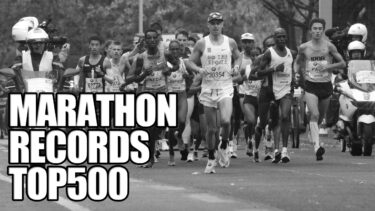When you participate in a marathon or watch elite athletes compete, you might hear phrases like, “This race is certified by XX.” Did you know that marathon races have various “classifications” and “certifications,” each with distinct purposes and roles?
In this article, we’ll clearly explain the differences between World Athletics (WA), AIMS, WA-certified Label Races, and the Abbott World Marathon Majors (AWMM) – all key players in the world of road running.

What’s the Difference Between World Athletics (WA) and AIMS?
Let’s start by looking at World Athletics (WA) and AIMS, often considered the two major organizations in road running.
What is World Athletics (WA)?
World Athletics (WA), formerly known as the International Association of Athletics Federations (IAAF), is the international governing body for all athletics disciplines. Established in 1912, WA sets the rules for athletics, ratifies world records, manages anti-doping efforts, and oversees major competitions like the World Championships. Essentially, it governs every aspect of the sport.
WA is the highest authority in athletics, with national federations (like Japan’s JAAF) affiliated with it. Its primary role is to promote the fairness, integrity, and development of athletics on a global scale.
What is AIMS?
On the other hand, AIMS stands for the “Association of International Marathons and Distance Races.” This is an international association comprised of organizers of marathons and long-distance road races. Founded in 1982, it wasn’t established by a specific individual or company, but rather by a collective of road race organizers worldwide, acting as a kind of “industry association.”
AIMS specializes in road races, aiming to promote them, enhance the quality of event organization, and facilitate information exchange among its member organizers. It plays a crucial role in setting standards for road race course measurement and collaborates with WA in the process of ratifying world records.
Relationship Between WA and AIMS
| Feature | World Athletics (WA) | AIMS (Association of International Marathons and Distance Races) |
| Type of Organization | International governing body for all athletics | International association of road race organizers |
| Scope | All athletics disciplines (track, field, road, etc.) | Specialized in road races (marathons, half marathons, etc.) |
| Main Roles | Rule-making, world record ratification, anti-doping, major event management, overseeing national federations | Road race promotion, operational support, course measurement standards, information sharing among members |
| Relationship | AIMS’s activities in road running adhere to WA’s rules and operate in cooperation with WA. | Not under WA’s direct authority, but a partner organization that collaborates with WA in the road running sector. |
Simply put, you can think of WA as the “government” for all of athletics, while AIMS acts as an “industry association” in the specific field of road races, contributing to their development in cooperation with WA.
“Label Races” and “World Marathon Majors” Certifications
Now, let’s explore the “classifications” of marathon races themselves: the World Athletics (WA) Label Races and the Abbott World Marathon Majors (AWMM).
What are World Athletics (WA) Label Races?
WA’s Label Races aim to guarantee the quality of road races worldwide and foster athlete performance. They particularly emphasize elite athlete participation, doping control, and accurate course measurement.
There are several types of Labels, differing in strictness and prestige:
- Platinum Label: The highest level of certification, awarded to the world’s premier races. It requires elite athlete participation and rigorous doping controls.
- Gold Label: Awarded to races at the next level below Platinum.
- Elite Label: The level below Gold Label.
- Label: Awarded to races meeting basic WA standards.
Key certification criteria include elite athlete participation requirements (number, level), accurately measured courses (requiring two certified measurers, one of whom must hold the highest qualification), doping control, medical services, safety management, and environmental considerations.
What are the Abbott World Marathon Majors (AWMM)?
The Abbott World Marathon Majors (AWMM) aim to create a series of the world’s most prestigious marathon races, promoting the development of marathon running and boosting runner motivation.
Currently, the following seven major marathons are certified as part of the AWMM series (the Sydney Marathon was added starting November 2024):
- Boston Marathon (USA)
- London Marathon (UK)
- Berlin Marathon (Germany)
- Chicago Marathon (USA)
- New York City Marathon (USA)
- Tokyo Marathon (Japan)
- Sydney Marathon (Australia)
Completing these seven races earns runners a “Six Star Medal” (the name remains unchanged even with Sydney’s addition), a significant motivator for general participants. For elite athletes, performance in these races contributes to the AWMM Series Championship points and offers substantial prize money.
Relationship Between Label Races and World Marathon Majors
WA’s Label Races evaluate “the quality and international competitive standard of a marathon race itself.” In contrast, the AWMM certification represents the “series” of the most prestigious marathon races, emphasizing the sense of accomplishment from completing them.
Crucially, all races certified by AWMM are also awarded WA’s Platinum Label. This means that AWMM races meet the highest standards set by World Athletics.
In simple terms, a WA Label is a “proof of a good race,” while AWMM is a “group of the most prestigious races in the world.”
Examples of Label Races!
Label certifications change annually, so always check the official World Athletics website for the latest information. Here are some notable examples:
World Athletics Platinum Label Races
These races are among the world’s top-tier events.
- Examples from Europe and the Americas:
- Boston Marathon (USA)
- London Marathon (UK)
- Berlin Marathon (Germany)
- Chicago Marathon (USA)
- New York City Marathon (USA)
- Amsterdam Marathon (Netherlands)
- Valencia Marathon (Spain)
- Examples from Japan:
- Tokyo Marathon
- Nagoya Women’s Marathon
- Osaka Women’s Marathon
- Examples from Asia, Oceania, etc.:
- Sydney Marathon (Australia)
- Seoul International Marathon (South Korea)
- Shanghai Marathon (China)
- Xiamen Marathon (China)
World Athletics Gold Label Races
These races are highly regarded internationally, just below Platinum Label events.
- Examples from Europe and the Americas:
- Barcelona Marathon (Spain)
- Rotterdam Marathon (Netherlands)
- Copenhagen Half Marathon (Denmark)
- Houston Marathon (USA)
- Examples from Japan:
- Examples from Asia, Oceania, etc.:
- Mumbai Marathon (India)
- Guangzhou Marathon (China)
World Athletics Elite Label Races
These races are a step below Gold Label, featuring promising elite athletes and high-quality organization.
- Examples from Europe and the Americas:
- Paris Marathon (France)
- Sevilla Marathon (Spain)
- Rome Marathon (Italy)
- Lisbon Half Marathon (Portugal)
- Examples from Japan:
- Beppu-Oita Mainichi Marathon
- Hofu Yomiuri Marathon
- Kagawa Marugame International Half Marathon
- Gifu Seiryu Half Marathon
Understanding these labels and certifications can give you a deeper insight into the characteristics and competitive level of each marathon. We hope this helps you in choosing your next race or enjoying the next big event!
Ever run a marathon and wondered, "Is this really 42.195 km?" The truth is, the distances of the marathon courses we ru[…]








